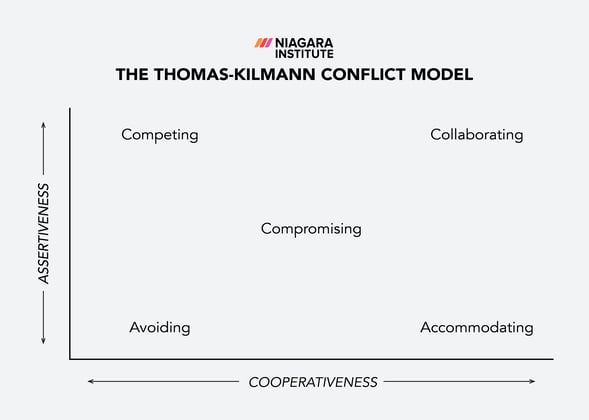2 min read
Conflict Styles Quiz: What's Your Approach to Conflict?
No one likes conflict, especially at work. But disagreements between those you work with are sometimes inevitable. So, the question isn’t how you...

With the goal of fostering healthy and productive work relationships, many of us strive to come to a mutual agreement when conflict arises with a colleague. An article from the Society for Human Resources Management confirmed this. They noted a survey where 64% of respondents agreed they would rather compromise than perpetuate a conflict at work by continuing to argue their point.
The compromising conflict style is one of five conflict resolution strategies individuals use when a dispute arises. In an assessment by the Niagara Institute, we uncovered the compromising conflict management style was the second most popular, with 24.4% of respondents using this style. Take the Conflict Management Styles Quiz at the bottom of this article to see if you approach conflict with the compromising style.
Two US psychologists, Kenneth Thomas and Ralph Kilmann developed the five conflict management styles to categorize how individuals respond to conflict. Their model chart each style based on how assertive or cooperative they are in their model. The compromising style falls directly in the center.

Unlike the collaborating conflict style, which focuses on creating a win-win, those who use the compromising conflict style focus on settling a conflict by finding a mutually acceptable solution that partially satisfies everyone involved.
It is best adopted in conflicts where you do not have a lot invested or where the topic is only moderately important to you. In which cases, you’d be more willing to give up some or most of what you want to settle the conflict quickly and preserve the relationship. You’re not intent on finding the perfect solution, just one that is “good enough” so that you can move forward with as little fallout as possible.
While this is arguably a fair and equal way to resolve a conflict, as both parties have to give something up, the fact is that the resolution is often unsatisfying and temporary as it does not address and solve the root of the conflict. Not to mention, it may leave residual feelings of frustration and resentment, which cause the issue to arise again or for those involved to be unwilling to compromise again.
Use Compromises as Temporary Solutions
Conflicts at work can often be traced back to large and complex issues that require time, energy, and resources to understand and address fully. Fortunately, a compromise can be used as a temporary solution. By presenting a compromise, not as a final or definite solution, but as a temporary or interim solution, you may find those involved in the conflict are far more willing to engage in and accept it.
Identify What You Are and Aren’t Willing to Compromise On
In any dispute, there will be things you are and are not willing to compromise. Not only should you know what these are before engaging in any negotiations, but you should also make an effort to uncover which items the other person is or is not willing to compromise. In doing so, you will pinpoint the areas you’re ready to give up and vice versa for the other person, which will make the resolution process far more efficient and effective.
Evaluate a Compromise Before Accepting It
When you get to the point in a conflict where a compromise is proposed, it can be tempting to rush to agree so that you can close the book and move forward. However, it can be a pitfall to do so. Before accepting any compromise, take the necessary time to evaluate the agreement. Ask yourself, am I giving up too much? Will I resent this decision and the person I made it with later? Are there any foreseeable problems with this compromise?
When you find yourself trying to resolve conflict at work, how do you handle the situation and pressure associated with it? Take this quiz to understand which conflict management style you naturally use and read the corresponding guide to select the right style for different scenarios you may encounter at work.

2 min read
No one likes conflict, especially at work. But disagreements between those you work with are sometimes inevitable. So, the question isn’t how you...

10 min read
Workplace conflict is bound to happen. When individuals are passionate and committed to their accountability for results, differing opinions will...

4 min read
How do you react to conflict at work? Do you cancel a meeting with the person you disagree with? Or walk a different route to avoid them in the...